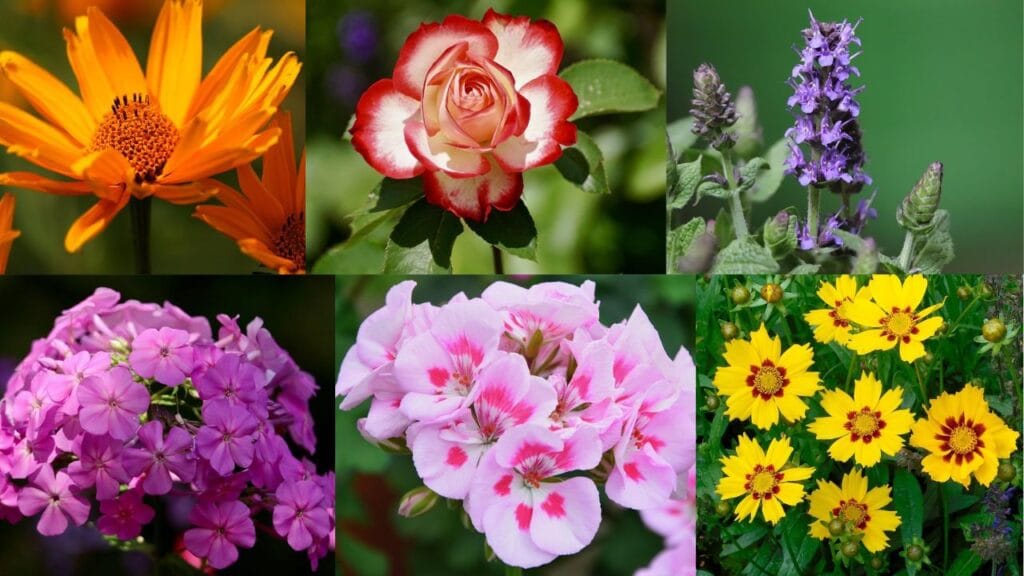Introduction
As summer reaches its peak, many garden favorites start to look a little tired—spent blooms droop, stems grow leggy, and the vibrant color of early summer begins to fade. But with a little well-timed care in August, you can revive your garden for a spectacular late-season show. Cutting back certain flowering plants now encourages fresh growth, prevents disease, and stimulates a second flush of vibrant blossoms that can last well into fall. Whether you love the classic charm of roses, the cheerful faces of daisies, or the soothing fragrance of lavender, giving them a mid-season trim can make all the difference.
In this guide, we’ll highlight 10 flowering plants you should cut back in August—along with simple pruning tips to keep them healthy, tidy, and bursting with blooms. With the right approach, your garden can end the season just as beautifully as it began.
Why Cutting Back in August
By late summer, many perennials and annuals have spent much of their energy producing early blooms and seeds. Removing faded flowers and trimming back stems redirects the plant’s energy from seed production to new growth and blossoms. This refresh can:
- Extend the flowering season
- Improve plant health
- Reduce pests and diseases
- Keep plants tidy and attractive
1. Geraniums (Pelargoniums)
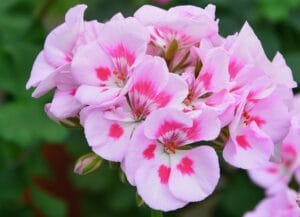
Geraniums (Pelargoniums) are vibrant, easy-to-grow flowering plants loved for their colorful blooms and aromatic foliage. Perfect for garden beds, borders, or containers, they thrive in full sun and well-drained soil. By August, geraniums may become leggy, so trimming back encourages bushier growth and more flowers in the late season. Regular deadheading not only keeps them looking neat but also extends their blooming period well into fall, making them a summer garden favorite.
- Remove spent flower stalks down to the base.
- Trim back overgrown stems by one-third.
- Feed with a balanced fertilizer after pruning.
Extra Tip:
Place pruned stems in water to propagate new plants for next year.
2. Roses
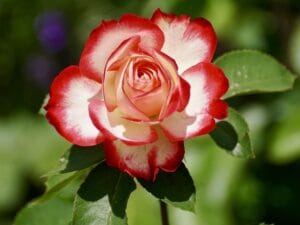
Roses are timeless garden favorites, celebrated for their beauty, fragrance, and versatility. Available in countless colors and varieties, they bloom from spring through fall with proper care. Cutting back roses in August removes faded blooms, stimulates new growth, and encourages a late-season flush of flowers. Regular pruning also improves airflow, reduces disease, and keeps plants looking vibrant, ensuring your garden remains stunning well into the cooler months.
- Remove dead or fading blooms down to the first outward-facing leaf with 5 leaflets.
- Trim away weak or spindly growth.
- Water deeply after pruning.
Extra Tip:
Apply a slow-release fertilizer to give roses an energy boost for their next bloom cycle.
3. Lavender
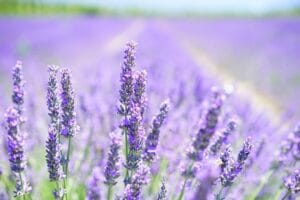
Lavender is a fragrant perennial herb loved for its soothing aroma and vibrant purple blooms. Blooming in summer, it attracts bees, butterflies, and other pollinators. Cutting back lavender in August after flowering keeps the plant compact, prevents woody growth, and encourages healthy foliage. Dried lavender flowers are perfect for sachets, teas, and crafts, making it a versatile addition to gardens and homes while enhancing beauty and relaxation.
- Remove spent flower spikes just above the leafy growth.
- Avoid cutting into old woody stems.
- Keep the plant rounded to prevent splitting.
Extra Tip:
Dry the harvested flower spikes for fragrant sachets or potpourri.
4. Coreopsis
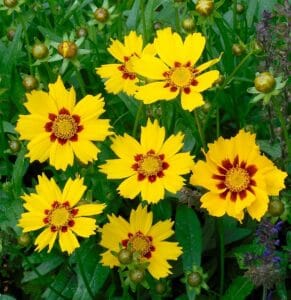
Coreopsis, often called tickseed, is a cheerful perennial known for its bright yellow, daisy-like blooms that light up summer gardens. Blooming from early summer to fall, it thrives in full sun and well-drained soil, attracting butterflies and pollinators. Cutting back Coreopsis in August encourages fresh growth and a second wave of flowers, keeping gardens vibrant into late summer while maintaining a neat, compact shape.
- Snip spent flowers down to the next set of leaves.
- If the plant is very tired, cut back by one-third.
Extra Tip:
Mulch around the base to conserve moisture and keep roots cool.
5. Catmint (Nepeta)

Catmint (Nepeta) is a hardy, drought-tolerant perennial loved for its soft, aromatic foliage and abundant lavender-blue blooms. Flowering from late spring to summer, it attracts bees, butterflies, and hummingbirds. Cutting catmint back in August encourages fresh growth and a second flush of flowers. Thriving in full sun and well-drained soil, it’s low-maintenance, deer-resistant, and ideal for borders, cottage gardens, or pollinator-friendly landscapes.
- Shear the plant back by half after the first bloom cycle.
- Remove any brown or damaged stems.
Extra Tip:
Catmint thrives in poor soil—avoid over-fertilizing to keep blooms prolific.
6. Shasta Daisies
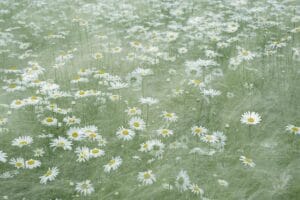
Shasta daisies (Leucanthemum × superbum) are classic perennial garden favorites known for their cheerful white petals and bright yellow centers. Blooming from early summer to fall, they thrive in full sun and well-drained soil. Cutting back spent blooms in August encourages a fresh flush of flowers for late summer. Low-maintenance, deer-resistant, and pollinator-friendly, Shasta daisies add timeless beauty and charm to borders, cottage gardens, and cut flower arrangements.
- Deadhead individual flowers to the next side shoot.
- For a full refresh, cut stems down to basal foliage.
Extra Tip:
Water consistently after cutting to encourage regrowth.
7. Phlox (Garden Phlox)
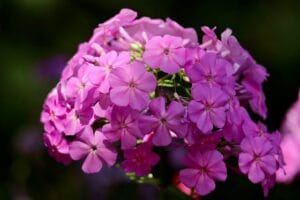
Phlox is a vibrant perennial known for its clusters of fragrant, star-shaped flowers that bloom in shades of pink, purple, red, and white. Popular in summer gardens, it attracts butterflies and pollinators, adding lively color to borders and flower beds. Garden phlox thrives in full sun and well-drained soil. Regular deadheading in August encourages fresh blooms, while good air circulation helps prevent powdery mildew for healthier, longer-lasting plants.
- Remove spent flower heads just above a set of leaves.
- Trim back overly tall stems to encourage side shoots.
Extra Tip:
Ensure good air circulation to prevent mildew.
8. Black-Eyed Susan (Rudbeckia)
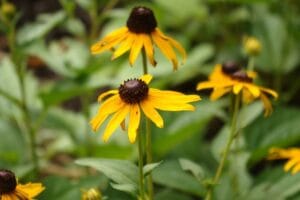
Black-Eyed Susan (Rudbeckia hirta) is a cheerful, sun-loving perennial known for its bright golden-yellow petals and dark brown centers. Blooming from summer into fall, it attracts butterflies, bees, and birds, making it a pollinator-friendly garden favorite. Easy to grow and drought-tolerant once established, Black-Eyed Susan thrives in full sun and well-drained soil, adding vibrant color and charm to borders, meadows, and wildflower gardens with minimal maintenance.
- Snip spent blooms to the next lateral bud.
- For a neat look, trim plants by one-third after the main flush.
Extra Tip:
Leave a few seed heads for birds if you want to attract wildlife.
9. Salvia
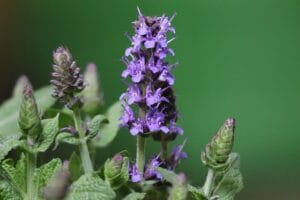
Salvia, a vibrant and versatile flowering plant, is prized for its long-lasting blooms and ability to attract pollinators like hummingbirds and butterflies. Blooming in brilliant shades of blue, purple, red, and pink, Salvia thrives in sunny spots with well-drained soil. Cutting back spent flower stalks in August encourages a fresh wave of blossoms, keeping your garden colorful and lively well into late summer and fall while promoting healthy plant growth.
- Remove flower stalks down to the basal rosette.
- Give a light feed to support regrowth.
Extra Tip:
Salvias attract hummingbirds and pollinators—perfect for a lively garden.
10. Coneflowers (Echinacea)
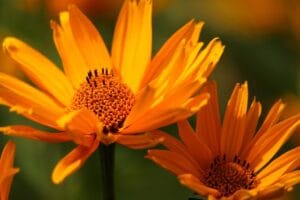
Coneflowers (Echinacea) are hardy, drought-tolerant perennials known for their daisy-like blooms and prominent cone-shaped centers. Blooming from summer into fall, they attract pollinators like bees, butterflies, and hummingbirds. Available in shades of pink, purple, yellow, and white, coneflowers thrive in full sun and well-drained soil. Easy to grow and low-maintenance, they also provide winter interest if seed heads are left for birds like goldfinches.
- Snip fading blooms down to the nearest strong leaf.
- Thin out overcrowded stems.
Extra Tip:
Mix your approach—leave a few seed heads for goldfinches while cutting others for continued flowering.
General Tips for Cutting Back in August
- Timing: Choose a cool morning or evening to reduce plant stress.
- Tools: Use sharp, clean pruners to prevent disease spread.
- Aftercare: Water deeply and apply a balanced, slow-release fertilizer.
- Pest Check: Pruning time is perfect for spotting insects or disease early.
Benefits of August Pruning
- Prolonged Bloom Season – Keeps your garden colorful well into fall.
- Healthier Plants – Reduces disease risk by removing decaying matter.
- Better Airflow – Thinning out plants prevents fungal infections.
- Tidy Appearance – A neat garden is more enjoyable for you and visitors.
- Wildlife Friendly – Controlled cutting lets you manage both flowers and seed for birds.
FAQ
- Why should I cut back flowering plants in August?
Cutting back encourages fresh growth and a second flush of blooms before fall. - Which plants benefit most from August pruning?
Roses, lavender, coneflowers, coreopsis, catmint, and other summer bloomers respond well. - Does cutting back damage plants?
No, if done correctly, it rejuvenates and strengthens them. - How much should I trim?
Generally, remove one-third of the plant or cut to just above healthy leaves. - Should I fertilize after pruning?
Yes, applying a balanced fertilizer boosts regrowth and flowering. - Can I prune in hot weather?
Yes, but prune in the cool morning or evening to reduce stress. - Is deadheading the same as cutting back?
Deadheading removes spent blooms; cutting back involves deeper trimming for regrowth. - Do all flowering plants like an August cut-back?
No, some fall-blooming plants should be left untouched until after flowering. - What tools should I use?
Sharp, clean pruners or shears to avoid disease spread. - Will cutting back attract pollinators?
Yes, more blooms in late summer will draw bees, butterflies, and hummingbirds.
Final Thoughts
Cutting back flowering plants in August isn’t just about looks—it’s about giving your garden a second wind before autumn arrives. Whether you’re tending classic roses, cheerful daisies, or fragrant lavender, a little mid-season care will reward you with a vibrant late-summer display.

